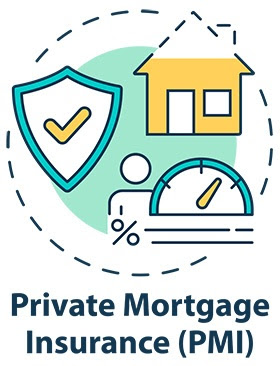| Private Mortgage Insurance Explained |
 |
 When a lender looks at a loan application, their main question is "what risk do I take on by issuing this loan?" Credit checks, bank statements, employment verification – all the documentation required when getting approved for a loan is in service of assessing what the odds are that the loan will go into default. This is why a down payment is such a crucial part of obtaining a home loan. When a borrower has a substantial down payment (20 to 30% or more), the lender's exposure is lessened in the event of a default. When a lender looks at a loan application, their main question is "what risk do I take on by issuing this loan?" Credit checks, bank statements, employment verification – all the documentation required when getting approved for a loan is in service of assessing what the odds are that the loan will go into default. This is why a down payment is such a crucial part of obtaining a home loan. When a borrower has a substantial down payment (20 to 30% or more), the lender's exposure is lessened in the event of a default.This 20-30% figure used to be required, yet clearly this kept a lot of people from realizing the benefits of homeownership, especially first time buyers. That is until 1957, when Max H. Karl, a real estate attorney, founded Mortgage Guaranty Insurance Corporation and invented the modern form of private mortgage insurance. PMI is designed to address the hefty down payment hurdle. Instead of coming to the table with 20% or more for a down payment, a private mortgage insurance policy allows consumers to buy and finance a home without a large down payment. With PMI, the borrower pays a small percentage of the total loan amount (0.3 - 1.5%/year) in addition to their mortgage and insurance payments. As an example, a $200,000 loan with a PMI rate of 1% will come out to $167 dollars extra a month for a borrower. It's not nothing, but for many it's a manageable trade off. Yet sometimes PMI can get a bad rap, as something to be avoided at all costs. Until the end of the 90's this attitude was understandable – homeowners had limited resources to cancel PMI and were often stuck with it for the life of their loan. That changed with the Homeowners Protection Act of 1998. It required automatic termination of PMI when the loan balance reaches 78% of the original value through natural amortization. Borrowers can often drop their PMI even before reaching that 78% figure – once a borrower reaches 20% equity in their home, they can request a cancellation of PMI. As home prices continue to rise, borrowers build up equity in their homes faster, meaning they can often drop PMI payments earlier than they think. If you're curious about buying a home for the first time, or you're wondering how the value of your home has changed over time, reach out to me. I have up-to-date market information to help you make decisions with confidence. |
Comments
Post a Comment